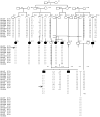A novel autosomal recessive non-syndromic deafness locus (DFNB35) maps to 14q24.1-14q24.3 in large consanguineous kindred from Pakistan
- PMID: 12529709
- PMCID: PMC2917542
- DOI: 10.1038/sj.ejhg.5200905
A novel autosomal recessive non-syndromic deafness locus (DFNB35) maps to 14q24.1-14q24.3 in large consanguineous kindred from Pakistan
Abstract
Autosomal recessive nonsyndromic deafness is one of the most frequent forms of inherited hearing impairment. Over 30 autosomal recessive nonsyndromic hearing loss loci have been mapped, and 15 genes have been isolated. Of the over 30 reported autosomal recessive nonsyndromic hearing loss (NSHL) loci, the typical phenotype is prelingual non-progressive severe to profound hearing loss with the exception of DFNB8, which displays postlingual onset and DFNB13, which is progressive. In this report we describe a large inbred kindred from a remote area of Pakistan, comprising six generations and segregating autosomal recessive nonsyndromic prelingual deafness. DNA samples from 24 individuals were used for genome wide screen and fine mapping. Linkage analysis indicates that in this family the NSHL locus, (DFNB35) maps to a 17.54 cM region on chromosome 14 flanked by markers D14S57 and D14S59. Examination of haplotypes reveals a region that is homozygous for 11.75 cM spanning between markers D14S588 and D14S59. A maximum two-point LOD score of 5.3 and multipoint LOD score of 7.6 was obtained at marker D14S53. The interval for DFNB35 does not overlap with the regions for DFNA9, DFNA23 or DFNB5.
Figures

References
-
- Davis AC. Hearing in Adults. London: Whurr; 1995.
-
- Bergstrom L, Hemenway WG, Downs MP. A high risk registry to find congenital deafness. Otolaryngol Clin North Am. 1971;4:369–399. - PubMed
-
- Van Camp G, Smith RJH. Hereditary Hearing Loss Homepage. Aug, 2002. URL: http://dnalab-www.uia.ac.be/dnalab/hhh/
-
- Cohen M, Gorlin R. Epidemiology, etiology, and genetic patterns. In: Gorlin R, Toriello H, Cohen M, editors. Hereditary Hearing Loss and its Syndromes. Oxford: Oxford University Press; 1995. pp. 9–21.
Publication types
MeSH terms
Substances
Associated data
- Actions
- Actions
- Actions
- Actions
- Actions
- Actions
- Actions
- Actions
- Actions
- Actions
- Actions
Grants and funding
LinkOut - more resources
Full Text Sources
Medical
Molecular Biology Databases

